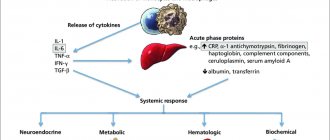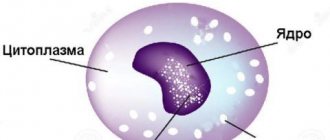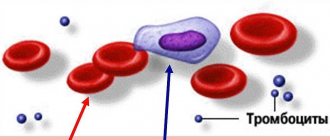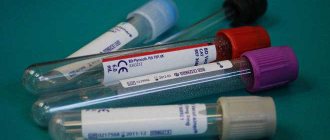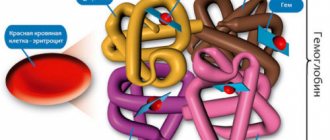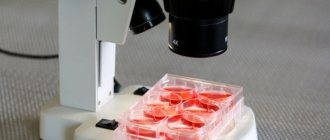General blood tests
07/24/201801/25/2019 Chernenko A. L. 1183 Views monocytes
Today we will figure out what monocytes are in a blood test. One of the most important basic blood tests is the assessment of the leukocyte formula. This study allows for a primary diagnosis of the state of the patient’s immune system, as well as to suspect the presence of acute infectious, autoimmune, etc. pathologies.
The leukocyte formula is represented by five types of leukocyte cells (neutrophil, lymphocyte, monocyte, eosinophil, basophil).
Monocytes are a small but very important group of leukocyte cells that provide phagocytosis processes in the body.
Further in the article we will look at what monocytes in the blood are, how and when a test for MONO (MON, monocytes) is carried out in a blood test, as well as what changes in this test mean (many monocytes in the blood, reduced number of monocytes).
- 1 What are monocytes in a blood test?
- 2 General information about monocytes
- 3 Blood test for monocytes
- 4 How is a blood test for leukocyte levels performed?
- 5 The norm of monocytes in the blood of women by age in the table
- 6 Reasons for deviation of monocytes from the norm
- 7 Reasons for a decrease in the number of monocytes
Functions in the body
Monocytes are a phagocyte that is found in the peripheral blood. The diameter of the leukocyte cell is no more than 18-20 microns, and in its center there is a polymorphic nucleus, which is distinguished by the presence of a loose chromatin network.
A feature of monocytes is that they, just like lymphocytes, contain an unsegmented nucleus. Externally, the monocyte cell has a bean-shaped shape, which is filled with a large amount of cytoplasmic fluid with a high concentration of lysosomes.
In women, the norm of the largest leukocyte is determined based on the results of a detailed blood test, taking into account the patient’s age, and the information obtained is entered into a special table of clinical indicators.
In people with a healthy lymphatic and hematopoietic system, monocytes circulate in the general bloodstream for 20-40 hours, and then migrate to soft tissues, where they are converted into macrophages. From this time on, they become part of the body's immune system.
The highest concentration of monocytic cells is concentrated in the lymph nodes, as well as in the tissues of the liver, spleen, and lungs. Leukocytes of this type have high mobility.
In the event of an acute inflammatory process or the penetration of pathogenic organisms into the body, they are able to change their localization, move along with the blood flow to the site of pathology and take part in the general immune response of the body. Monocytes also perform the following functions.
| Main functions of monocytes | Characteristics of the activity of monocytic cells in the human body |
| Phagocytosis | The function of phagocytosis is that monocytic cells, which are localized in the tissues of internal organs and lymph nodes, prevent the occurrence of inflammatory and infectious processes even at the stage of penetration of microbes into the human body. Monocyte cells are the first to attack fungal spores, bacteria and viruses that have entered the bloodstream, been carried along with the air flow, or penetrated an open wound on the skin surface of the body. After neutralizing pathogenic microorganisms, monocytes break them down by digestion, thereby replenishing their own energy costs. |
| Stimulate immune system responses | After the largest leukocytes in the blood are the first to respond to infectious invasion, the remaining mechanisms of the immune response are launched. The body directs all its forces to neutralize biological agents. The faster monocytes react to infection of the body with a bacterial, viral or fungal infection, the faster the general immune system will begin the process of fighting for the stable functioning of all organs and tissues. |
| Removing mutated cells | For the human body, degenerated and mutated cells are potentially dangerous biological agents. They are able to create a favorable basis for the development of tumor processes. Mutated cells can form benign and cancerous tumors localized in connective, bone, epithelial and other types of tissue. Monocytes detect, bind and remove degenerated cells from the body even before they manifest their pathogenic activity. |
| Cleansing tissues from pathogenic microorganisms and cell fragments | Mechanical injuries, acute infectious-inflammatory process, as well as other tissue damage lead to the fact that a large number of defective cells and bacterial microorganisms are concentrated at the site of pathology. Monocytes are the first to be sent to the damaged area of skin or soft tissue, cleanse them of cell debris and have a bactericidal effect. Thanks to this function of leukocytes, rapid restoration of the skin and regeneration of soft tissues occurs. |
| Immune memory | Monocytes accumulate information about pathogenic organisms that penetrated the bloodstream or epithelial tissues, exhibited pathogenic activity and were neutralized as a result of the immune response. The next generations of monocytic group cells already know how to act against a specific strain of infectious microorganisms, which significantly increases the protective function of the immune system. |
| Cytokine synthesis | In the human body, cytokines act as information molecules, which are of the peptide type. They take an active part in mobilizing the protective mechanisms of the immune system in response to the growing inflammatory process. Cytokines are physiological regulators of humoral and cellular immunity. They also have their own functional activity, providing antiviral and cytotoxic protection to the human body. |
Phagocytes of the monocytic group act synchronously, saturating the area of the inflammatory or infectious process to ensure a complete immune response.
Reasons for deviation of monocytes from the norm
An increase in monocytes in the blood can be caused by:
- acute infectious pathologies (usually of viral origin);
- parasitic and helminthic infestations;
- fungal infections;
- subacute infectious processes of bacterial origin (subacute inflammatory processes in the endocardium, rheumatic tissue damage);
- tuberculous lesions of lung tissue and lymph nodes;
- syphilis;
- brucellosis;
- malignant neoplasms;
- UC (nonspecific ulcerative colitis);
- systemic autoimmune pathologies;
- malaria;
- typhus;
- myeloproliferative pathologies;
- oncological blood diseases;
- malignant lymphomas;
- chronic course of herpes virus infection;
- infectious mononucleosis (the main cause of monocytosis in children, in which case monocytosis is combined with the identification of specific atypical mononuclear cells);
- specific monocytic leukemias, etc.
In patients with mycobacterial infections (tuberculosis), a high rate of monocytosis in combination with an increase in the number of neutrophil cells and a decrease in the number of lymphocytes may indicate relapse or progression of the infectious process.
An increase in the number of lymphocyte and monocytic cells against the background of a decrease in neutrophils is typical for recovering patients.
Normally, a slight increase in monocytic cells in women may be observed during menstruation.
Also, an increase in the number of monocytes can be observed in patients undergoing treatment with ampicillin ®, griseofulvin ®, haloperidol ®, prednisolone ®, etc.
How and under what conditions is it produced?
Previously, hematologists believed that phagocytes of this type are formed in the reticuloendothelial system. Recent scientific research has shown that monocyte synthesis occurs in bone marrow tissue.
Mature leukocytes, which have the most powerful phagocytic properties, are released into the bloodstream. The cells mature over the next 5 days, and then they become part of the peripheral blood.
The process of monocyte synthesis is inhibited during the period of taking drugs from the glucocorticoid group, as well as if a person is under constant stress for a long time. In this regard, immunity decreases, and the human body becomes more susceptible to infection by infectious, viral and fungal microorganisms.
Some features of monocytes
The vast majority of monocytes originate in the bone marrow from a multipatent stem cell, and from a monoblast (ancestor), pass through the stages of promyelomonocyte and promonocyte. Promonocyte is the last stage before the monocyte, the immaturity of which is indicated by a paler, loose nucleus and remnants of nucleoli. Promonocytes contain azurophilic granules (by the way, mature monocytes also have them), but, nevertheless, these cells belong to the agranulocytic series, since the granules of monocytes (lymphocytes, immature cells, histogenic elements) are stained with azure and are a product of protein discolloidosis of the cytoplasm. A certain (small) number of monocytes are formed in the lymph nodes and connective tissue elements of other organs.
The cytoplasm of mature monocytes contains various hydrolytic enzymes (lipases, proteases, verdoperoxidase, carbohydrase), and other biologically active substances, but the presence of lactoferrin and myeloperoxidase can only be detected in trace amounts.
Unlike other cells (for example, neutrophils), the body manages to accelerate the production of monocytes in the bone marrow only slightly, only two or three times. Outside the bone marrow, all cells belonging to phagocytic mononuclear cells proliferate very weakly and limitedly; cells that reach the tissues are replaced only by monocytes circulating in the blood.
Having entered the peripheral blood, monocytes live in it for no more than 3 days, then move to the surrounding tissues, where they finally mature into histiocytes or various highly differentiated macrophages (Kupffer cells of the liver, alveolar macrophages of the lungs).
Video: what are monocytes - medical animation
The table is normal
Monocytes (the norm for women by age, a table of clinical indicators is compiled based on the results of a diagnostic examination of the body) are cells of the leukocyte group, which are determined in a biochemical laboratory. For healthy children, men and women who do not suffer from pathologies of the hematopoietic system, the normal concentration of monocytic cells is as follows.
| Age | Percentage of phagocytes in the cellular composition of blood |
| Newborn baby 2 weeks old | From 5 to 15% |
| Children aged 2 weeks to 1 year | From 4 to 9% |
| Child aged 1 to 2 years | From 3 to 10% |
| Children from 2 to 15 years old | From 3 to 9% |
| Boys and girls over 15 years old | From 3 to 11% |
| Adult men and women | From 4 to 11% |
The normal levels of phagocytes in the blood of men and women are identical. As the body naturally ages, acquires concomitant diseases, or abuses bad habits, the concentration of monocytic cells may decrease or increase. The main thing is that the indicators of the biochemical blood test remain within the above limits.
The norm of monocytes in the blood of men by age - table
What is the norm of monocytes in the blood of men? Blood performs many functions, one of them is protective. This happens through specialized cells found in the blood. These cells include monocytes. These are large mature leukocytes and belong to the agranulocyte group. They are produced in the human bone marrow and then transported into the bloodstream.
Next, monocytes move into tissues and transform into macrophages, while doing the same job. The main function of monocytes is to engulf foreign objects such as bacteria or viruses. You can determine the number, as well as the norm, of monocytes in the blood of men using a CBC. With the correct interpretation of the result, it is possible to assess the state of a person’s health at the moment.
Normal for men
Monocytes have the ability to move, so they often go beyond the boundaries of the blood circulation. They can concentrate directly at the site of infection. Thanks to the synthesis of cytokines, these formed elements have a pronounced antitumor, antimicrobial and antiviral effect.
Initially, monocytes are determined by calculating the leukocyte formula. It is part of the UAC. Blood is drawn from a finger. The test is taken on an empty stomach; it is not recommended to drink any liquid immediately before the test; you should also refrain from smoking.
If the cause of the increase in monocytes cannot be determined, then an additional puncture of the cerebrospinal fluid is taken and examined.
When receiving the results of a blood test, you can find that monocytes are expressed both as a percentage and in quantity. This is due to the fact that the indicator can be absolute and relative.
The relative indicator indicates the number of monocytes contained in the blood, if the remaining blood elements are taken as 100%. Despite its importance in the body, the cell content is normally low. For men, the normal range ranges from 3 to 10%.
The absolute indicator is indicated by a numerical value and shows the number of cells in one liter of blood. The norm of monocytes in the blood of men is 8*107. The level of monocytes in men does not change with age; it remains at a certain level throughout their lives from the age of 18. But before adulthood, jumps in this indicator are observed, which is considered a normal state.
If the test results are elevated, monocytosis is diagnosed; if their number is reduced, monocytopenia is diagnosed.
If the indicators are elevated, the doctor prescribes a more in-depth study, as this may indicate an inflammatory and infectious process developing in the body.
If the concentration of this indicator in a person’s blood is increased, then a number of pathologies developing in the body can be suspected. Most often, this indicator is prescribed as a confirmatory test, since it takes time to accumulate.
The following pathologies can be the causes of monocytosis:
- Oncological diseases, mainly all tumors of a malignant nature. Most often, severe mononucleosis is observed in oncology in elderly people.
- Almost all viral, bacterial or fungal infections. The increase occurs due to the active struggle of monocytes with various types of bacteria and viruses. Mainly for diseases such as influenza, rubella, diphtheria, tuberculosis or syphilis.
- With mononucleosis, especially in adults, the white blood cell count is greatly increased.
- In the inflammatory process of the small or large intestine, especially in the acute phase;
- Autoimmune diseases such as lupus erythematosus or rheumatism.
- Postoperative period.
It is worth noting that this indicator remains elevated even after full recovery. It can return to normal values within a month. And in children, monocytosis can be observed even during teething or changing teeth.
Decreased monocytes
A decrease in monocytes or monocytopenia is also a pathological condition for humans. With the help of this analysis, a competent doctor can find the cause of the disease and make the correct diagnosis.
So, a decrease in the indicator may indicate the following pathologies:
- severe depletion of the immune system, after any illness, leads to a decrease in the indicator;
- anemia, mainly in severe cases;
- when taking certain chemotherapy drugs, as well as treatment with glucocorticosteroids;
- pregnancy, especially the first trimester;
- leukemia in an advanced stage;
- some infectious diseases, such as typhoid fever or paratyphoid fever;
- radiation sickness.
It happens that this indicator is not determined at all in the analysis. Then we can talk about the progression of leukemia, since the immune system is completely unable to cope with the disease.
Another such anomaly is observed in blood sepsis. In this case, massive destruction of blood cells occurs under the influence of the toxin, while phagocytes cannot cope with intoxication.
Unfortunately, this condition most often leads to death.
Thus, monocytes are one of the most important formed elements of the immune system. They support optimal levels of immune function. They are also a kind of confirmatory laboratory test for diagnosing the disease. Therefore, any change in this indicator must be strictly investigated.
Source: https://BolezniKrovi.com/analizy/norma-monotsitov-v-krovi-u-muzhchin.html
Symptoms of increase and decrease
An increase in the level of phagocytes is almost always associated with a pre-existing disease of the internal organs or soft tissues.
In this case, the woman experiences the following symptoms:
- increased body temperature, which can range from 37 to 40 degrees Celsius;
- severe headache, chills, fever;
- epigastric pain, possible nausea and vomiting;
- shortness of breath, feeling of lack of air and rapid heartbeat;
- frequent urge to urinate;
- complete or partial loss of appetite;
- possible intestinal dysfunction, which is expressed in attacks of liquid diarrhea (this symptom manifests itself if there has been an infectious invasion of the gastrointestinal tract);
- red rash, hives, swelling that appears on various parts of the body, and is also accompanied by severe itching;
- inflammation of the oral mucosa, swelling of the tonsils, gingivitis.
Signs of increased monocyte levels may be expressed in other pathological conditions of the body. It all depends on what disease provoked a sharp surge in the phagocytic activity of the immune system.
A decrease in monocyte concentration is most often manifested by the following symptoms:
- the body’s tendency to frequent colds, infectious, viral and fungal diseases;
- feeling of constant fatigue;
- decreased ability to work;
- drowsiness;
- ulcerative lesions of the skin surface and the development of various types of dermatitis;
- changes in the biochemical composition of blood;
- dyspnea;
- tachycardia, as well as other signs of disturbances in the rhythmic activity of the heart.
As in the case of an increase in the level of monocytes, a decrease in their concentration also indicates the presence of an acute or chronic disease of the body, or is a consequence of heavy blood loss.
monocytes normal in men by age table
What is the norm of monocytes in the blood of men? Blood performs many functions, one of them is protective. This happens through specialized cells found in the blood. These cells include monocytes. These are large mature leukocytes and belong to the agranulocyte group. They are produced in the human bone marrow and then transported into the bloodstream.
Next, monocytes move into tissues and transform into macrophages, while doing the same job. The main function of monocytes is to engulf foreign objects such as bacteria or viruses. You can determine the number, as well as the norm, of monocytes in the blood of men using a CBC. With the correct interpretation of the result, it is possible to assess the state of a person’s health at the moment.
Monocytes have the ability to move, so they often go beyond the boundaries of the blood circulation. They can concentrate directly at the site of infection. Thanks to the synthesis of cytokines, these formed elements have a pronounced antitumor, antimicrobial and antiviral effect.
Initially, monocytes are determined by calculating the leukocyte formula. It is part of the UAC. Blood is drawn from a finger. The test is taken on an empty stomach; it is not recommended to drink any liquid immediately before the test; you should also refrain from smoking.
When receiving the results of a blood test, you can find that monocytes are expressed both as a percentage and in quantity. This is due to the fact that the indicator can be absolute and relative.
The relative indicator indicates the number of monocytes contained in the blood, if the remaining blood elements are taken as 100%. Despite its importance in the body, the cell content is normally low. For men, the normal range ranges from 3 to 10%.
The absolute indicator is indicated by a numerical value and shows the number of cells in one liter of blood. The norm of monocytes in the blood of men is 8 * 10 7 . The level of monocytes in men does not change with age; it remains at a certain level throughout their lives from the age of 18. But before adulthood, jumps in this indicator are observed, which is considered a normal state.
If the test results are elevated, monocytosis is diagnosed; if their number is reduced, monocytopenia is diagnosed.
If the indicators are elevated, the doctor prescribes a more in-depth study, as this may indicate an inflammatory and infectious process developing in the body.
If the concentration of this indicator in a person’s blood is increased, then a number of pathologies developing in the body can be suspected. Most often, this indicator is prescribed as a confirmatory test, since it takes time to accumulate.
The following pathologies can be the causes of monocytosis:
- Oncological diseases, mainly all tumors of a malignant nature. Most often, severe mononucleosis is observed in oncology in elderly people.
- Almost all viral, bacterial or fungal infections. The increase occurs due to the active struggle of monocytes with various types of bacteria and viruses. Mainly for diseases such as influenza, rubella, diphtheria, tuberculosis or syphilis.
- With mononucleosis, especially in adults, the white blood cell count is greatly increased.
- In the inflammatory process of the small or large intestine, especially in the acute phase;
- Autoimmune diseases such as lupus erythematosus or rheumatism.
- Postoperative period.
A decrease in monocytes or monocytopenia is also a pathological condition for humans. With the help of this analysis, a competent doctor can find the cause of the disease and make the correct diagnosis.
So, a decrease in the indicator may indicate the following pathologies:
- severe depletion of the immune system, after any illness, leads to a decrease in the indicator;
- anemia, mainly in severe cases;
- when taking certain chemotherapy drugs, as well as treatment with glucocorticosteroids;
- pregnancy, especially the first trimester;
- leukemia in an advanced stage;
- some infectious diseases, such as typhoid fever or paratyphoid fever;
- radiation sickness.
It happens that this indicator is not determined at all in the analysis. Then we can talk about the progression of leukemia, since the immune system is completely unable to cope with the disease.
Another such anomaly is observed in blood sepsis. In this case, massive destruction of blood cells occurs under the influence of the toxin, while phagocytes cannot cope with intoxication.
Unfortunately, this condition most often leads to death.
Source: boleznikrovi.com
Interpretation of a general blood test for adult men and women
A complete blood count is one of the most common services used to assess health status.
In order for the test results to be as reliable as possible, it is necessary to properly prepare for their delivery.
You can get advice on the results of the research performed at a free consultation with a specialist.
If necessary, you can receive medical services without leaving your home.
Save on medical services by becoming a member of a special discount program.
Quality control of clinical laboratory tests, carried out according to international standards, is a powerful argument when choosing a medical center.
A complete blood count is one of the most common and most necessary diagnostic tests. It allows the doctor to assess the patient’s blood counts and quickly draw initial conclusions about his condition.
Reasons for promotion and demotion
Monocytes (the norm for women by age, a table of clinical indicators is compiled based on the results of a diagnostic examination of the body) are blood cells that are part of the body’s immune system, and an increase in their concentration indicates the possible presence of the following diseases:
- infection of the digestive system by helminths;
- invasion of bacterial, viral and fungal microorganisms;
- tuberculosis of the lymphatic system or lung tissue;
- typhoid fever;
- all types of sexually transmitted diseases (the most dramatic surge in monocyte activity is observed in the case of infection with syphilis);
- brucellosis;
- lymphomas of malignant etiology;
- monocytic leukemia of a specific type;
- blood damage by the malaria pathogen;
- all types of malignant neoplasms that are localized in any part of the body;
- herpesvirus infection, which was in a chronic form, and then moved to the acute stage;
- endocarditis and rheumatoid tissue destruction;
- skin damage associated with the parasitic activity of infectious microorganisms, acute allergic reaction or mechanical trauma.
During menstruation, most women allow a slight increase in the level of monocytes, which returns to normal 2-3 days after the end of menstruation. Such a reaction of the body is not a pathology.
A decrease in the concentration of phagocytes can be caused by the following reasons:
- internal bleeding;
- postoperative period of tissue restoration;
- severe traumatic brain injury;
- malignant neoplasms in the bone marrow;
- long-term therapy with Prednisolone, cytotoxic drugs, as well as immunosuppressants;
- state of shock;
- prolonged stay in conditions of psycho-emotional overstrain and stress;
- postpartum period;
- presence of aplastic anemia.
A decrease in the level of phagocytes is no less an alarming signal than an increase in their number. The reasons that caused the change in the cellular composition of the blood must be established in a biochemical laboratory.
Reasons for the increase
Exceeding the maximum permissible quantitative content of monocytes indicates the development of monocytosis.
Monocytosis develops in two forms:
- absolute - isolated production of macrophages in the blood, in which the concentration of these cells exceeds 1.1*109/l for children under 12 years of age and 0.8*109/l for an adult (pathology develops against the background of diseases that cause specific production professional phagocytes);
- relative - a condition characterized by a normal absolute content of monocytes, while their percentage in the blood is increased (pathology occurs against the background of a simultaneous decrease in the level of other leukocytes).
The absolute form of monocytosis is more dangerous compared to the relative form, because it is a sign of disorders in the body.
If the level of monocytes in the blood is increased, it means that phagocytosis and active destruction of foreign cells has begun. A slight increase in monocytes during the first two hours after eating is considered normal.
To avoid inaccuracies during research, it is necessary to take a blood test in the morning before meals.
If the level of phagocytes greatly exceeds the permissible values, this means that a person is developing a pathology that requires immediate identification and treatment.
Menstruation
The peculiarities of the female reproductive system determine a slight increase in acceptable values during the first days of the cycle, when the endometrium is actively rejected and the janitor cells begin their intensive work. Maximum monocyte levels are observed on days of heavy discharge. With the end of menstruation, the level of phagocytes normalizes. In order for the MON analysis to be accurate, doctors recommend taking it between menstruation.
Pregnancy
The immune system of a pregnant woman undergoes changes, so the first trimester is accompanied by a decrease in the level of janitor cells, and the third trimester and the period before childbirth is accompanied by its maximum increase. If the indicators do not go beyond the permissible upper and lower limits, then this is considered the norm.
Important information: What does increased red blood cells mean in an adult?
Acute infectious diseases
An increase in the number of phagocytes can occur against the background of the development of an infectious disease. With ARVI, a general blood test shows a slight excess of normal values. When a bacterial infection occurs, the number of neutrophils increases. Monocytes begin to fight viruses, and their increased content in the blood is observed from the first to the last day of illness. Increased concentrations of these elements may persist for 14-30 days.
If deviations from the norm are recorded after 1.5-2 months, it means that a chronic infection is developing. A cold is characterized by an increase in the level of monocytes to the upper limit of normal, and its slight excess is also allowed. If there is a sharp increase in monocytes, it is necessary to undergo examination to identify oncohematological pathology.
Infectious mononucleosis
This is a disease caused by the herpes-like Epstein-Barr virus. Occurs mainly in children of preschool age. The infection is considered common and is diagnosed in many children. Adults rarely suffer from infectious mononucleosis due to their developed immune system.
Main signs of the disease:
- sudden deterioration of the condition, against the background of which the body temperature rises to 40°C;
- the appearance of a runny nose, sore throat, nasal congestion;
- enlargement of the submandibular and occipital lymph nodes, which is not accompanied by pain;
- skin rash;
- enlarged spleen and liver.
The febrile state may persist for a month with periodic improvement in well-being. When performing a general blood test, an increased content of lymphocytes and monocytes is detected. To clarify the diagnosis, a test for specific antibodies is performed. Treatment consists of eliminating symptoms.
Tuberculosis
An infectious disease that leads to damage to the bones, lungs, genitourinary system, and skin.
Symptoms of the disease:
- prolonged fever that occurs for no reason;
- causeless weight loss;
- the appearance of a lingering cough (a sign of pulmonary tuberculosis);
- weakness, fatigue.
In order to detect pathology in a timely manner, adults undergo fluorography every year, and children undergo the Mantoux reaction. The diagnosis of pulmonary tuberculosis is confirmed using chest x-ray.
Tuberculosis with localization in other organs is determined using specific studies.
Parasitic infestation
The presence of helminths (pork tapeworm, bovine tapeworm, roundworms, pinworms, etc.) in the body is accompanied by activation of janitor cells.
Parasitic infestation is characterized by:
- pain in different areas of the abdomen;
- diarrhea;
- causeless weight loss with a good appetite;
- skin rash (urticaria).
A complete blood count reveals an increased content of monocytes and eosinophils. To confirm the diagnosis, stool analysis, bacterial culture, and immunological tests are performed.
Antiparasitic drugs are prescribed to treat the disease.
Chronic infectious and inflammatory processes
A chronic infection that has been present in the body for a long time causes an increased concentration of monocytes in the bloodstream.
Chronic pathologies do not have characteristic symptoms. The clinical picture of the disease depends on its form and location:
- throat;
- lungs;
- heart;
- kidneys;
- bone;
- pelvic organs;
- gallbladder.
Signs that may occur:
- pain, constant or periodic, in the area of the lesion;
- lethargy;
- increased fatigue.
After identifying the root cause, a program is drawn up to eliminate it. The content of monocytes normalizes along with the subsidence of chronic pathology.
Autoimmune diseases
Autoimmune diseases are diseases that are accompanied by the destruction of the immune system's own tissues. Monocytes take an active part in this process, and heart valves, joints, skin, and kidneys suffer.
Important information: What are T lymphocytes (types and functions)
Among autoimmune pathologies, the most common are:
- rheumatoid arthritis (destruction of small joints);
- diffuse toxic goiter (damage to the thyroid gland);
- systemic lupus erythematosus (damage to skin cells, heart valves, small joints, skin);
- diabetes mellitus type I (glucose metabolism disorders);
- systemic scleroderma (skin lesions spreading to internal organs).
Oncohematological pathology
If a sharp increase in the concentration of monocytes is not associated with autoimmune and infectious diseases, then the reason may be the development of blood cancers, such as:
- leukemia (myelomonocytic, acute monocytic);
- lymphogranulomatosis;
- multiple myeloma.
Chemical poisoning
In rare cases, monocytosis is caused by:
- Tetrachloroethane poisoning. The vapors of this substance enter the body through the skin or mouth and cause irritation of the mucous membranes, causing headaches and the development of jaundice. Possible liver damage.
- Phosphorus poisoning. The cause of poisoning can be interaction with contaminated dust or steam, or accidental ingestion. Acute poisoning is accompanied by diarrhea and abdominal pain. The liver, kidneys, and central nervous system are affected.
Manifestations of monocytosis are one of the signs of poisoning, which is taken into account when making a diagnosis.
Indications for the study
Monocytes (the norm for women by age, a table of clinical indicators is compiled based on the results of a diagnostic examination of the body) are large leukocytes that play a key role in the full functioning of the immune system.
Direct indications for testing the level of phagocytes are the presence of the following symptoms:
- frequent and unfounded intestinal disorders;
- increased body temperature without obvious signs of inflammation;
- tachycardia and disturbance of the rhythmic activity of the heart;
- dyspnea;
- dizziness and physical weakness;
- rapid fatigue after minor exertion;
- infectious and inflammatory skin diseases;
- chronic diseases of the nasopharynx, upper and lower respiratory tract;
- an allergic reaction that occurs in acute or chronic form.
The need for an analysis for the level of phagocytes in the blood serum is determined by the attending physician, who performs the initial examination of the patient.
Results
The patient receives the results of laboratory tests of blood and urine on a special form, where the study parameters are indicated by a Latin (English) abbreviation. Each indicator has its own level of content in the blood or urine.
Only a doctor can correctly decipher the results of the study, since all parameters are correlated with each other. The patient can only compare his results with reference values. The standards to be followed are usually indicated in the analysis form.
How to determine
The level of monocytes is determined by a laboratory blood test to determine the percentage of vital cells. Capillary and venous blood is suitable for diagnosis.
Simultaneously with the level of phagocytes, the concentration of leukocytes is identified. A comparative analysis of qualitative blood parameters makes it possible to establish the severity of the infectious and inflammatory process that progresses in the female body.
The importance of monocytes in the female body
In a woman's body, monocytes perform vital functions. They:
- Capable of destroying and neutralizing pathogenic and foreign organisms. Cells are able to swallow them whole. It is important that monocytes “swallow” objects, the number and size of which are very significant. This is beyond the capabilities of other groups of leukocytes.
- They provide their surface to T-helper cells (helper cells). The purpose of the latter is to strengthen adaptive immune resistance. It is aimed at the rapid destruction of pathogens wishing to invade the body.
- Participate in starting the process of necrosis deep in malignant cells. Monocytes have the same cytotoxic effect on malaria pathogens and parasitic protists.
- Promote the restoration of tissues that have been damaged, inflamed or affected by tumors.
- Cells (destroyed and dead), antigen-antibody complexes, and foreign bacteria are removed from the body.
Monocytes are irreplaceable, because they can do what other types of leukocytes cannot do: absorb pathogens in a highly acidic environment.
Abnormal cell levels weaken the body because the efficiency of white blood cells decreases. They cannot fully resist viruses and microbes.
Preparing and conducting analysis
Blood sampling for analysis is carried out exclusively in the morning from 07-00 to 10-00. Biological material is donated on an empty stomach.
During preparation for the study, the following rules will need to be observed:
- do not drink alcohol (24 hours before the test);
- the day before going to the laboratory, do not allow the body to become overtired;
- 48 hours before donating blood, avoid nervous tension;
- the last meal should take place the night before;
- do not smoke on the day of the test.
You must arrive at the blood donation point in advance so that within 10-15 minutes. it was time to rest. Before the test, you are allowed to drink no more than 250 ml of boiled water. Blood sampling is carried out under sterile conditions in a biochemical laboratory. To carry out the analysis, 5 to 10 ml of biological material is sufficient. The results of the study can be obtained in your hands after 2-3 days.
Functions of monocytes
The main function of monocytes is phagocytosis (capture and digestion of solid particles):
- They resist microbial infection,
- Participate in the body's immune response,
- Fight tumor cells
- Dissolve thrombotic masses,
- They destroy old, obsolete and dead blood cells.
Scheme of the phagocytosis process: phagocyte-monocyte (3) meets a microorganism (1-2), surrounds it with its cell mass (5), completes the environment and digests (6)
In addition to destroying cells unnecessary to the body, monocytes are responsible for preparing damaged tissues for regeneration, and also participate in regulating the process of hematopoiesis. Unlike neutrophils (leukocyte microphage cells), monocytes are more focused on viruses. In places where monocyte-macrophages are dislocated, there is never a purulent process.
How to get it back to normal
Restoring normal monocyte levels is only possible if the underlying disease is treated. Depending on the type of underlying disease, the following remedies can be used.
Medications
In the event that a violation of the monocyte norm is caused by bacterial infections, the following types of medications can be used:
- Erythromycin – a potent antibacterial agent, which is prescribed to take 1-2 tablets 3 times a day 1 hour before or after meals (the course of therapy ranges from 5 to 14 days, and the price of the medication is 75 rubles);
- Amoxil is a penicillin antibiotic, which is prescribed to take 500 mg 2 times a day for 5-7 days (the cost of the drug is 135 rubles);
- Biseptol is an antibacterial and anti-inflammatory drug that is prescribed for most infectious diseases that cause an increase in the level of monocytes (2 tablets are taken 2 times a day with a course of therapy of up to 2 weeks, and the price of the medicine is 175 rubles);
- Amoxiclav-kviktab is a medicine with the active substance in the form of amoxicillin, prescribed to take 1 tablet 2 times a day with a treatment duration of up to 14 days (the cost of the medicine is 250 rubles).
Taking the above drugs is possible only as prescribed by the attending physician, if the strain of the infectious microorganism that provoked the inflammatory process with an increase in the level of phagocytes is identified.
Traditional methods
Folk remedies are not used to reduce or increase the level of monocytes in the blood serum, since they are not able to affect the functionality of the bone marrow, or suppress an acute infectious-inflammatory process.
Other methods
In combination with drug therapy for the underlying disease, which provokes a surge in phagocyte activity, it is recommended to use the following methods that strengthen the immune system:
- long walks in the fresh air;
- dousing with cold water;
- wiping the body with a wet towel;
- taking a course of vitamin-mineral complexes (every 6 months);
- preventive spa treatment of chronic diseases.
The above methods are general strengthening and cannot be used as an independent method of therapy.
Monocytes
Monocytes are a type of white blood cell. Since they do not contain granules in the cell, they are classified as agranulocytes.
Counting monocytes is mandatory when determining the leukocyte formula of blood. This takes into account not only the absolute number of cells, but also their relative content - per 100 leukocytes.
The normal level of monocytes in the blood of men is 3–11%. Their absolute number ranges from 0.3 to 0.82 thousand/μl. Women may experience higher levels of these cells, especially during pregnancy.
An increase in agranulocytes is most often observed with viral infections, colds, and diseases of the ENT organs. In this case, monocytosis is of a mixed nature - absolute and relative. It is also observed in some bacterial diseases of the respiratory system:
In addition, monocytes in the blood can increase in autoimmune pathologies, leukemia, and malaria.
A decrease in these cells is very rare in a doctor’s practice. It may be associated with severe exhaustion of the patient.
You should know that a change in the monocyte count alone in men or women is not a diagnosis and cannot be an indication for treatment. The results of the analysis are necessarily considered together with the clinical picture of the disease and indicators of additional examination. Only the totality of all data allows us to establish the correct diagnosis and select the optimal therapy.
Possible complications
Potential complications from too high or low monocyte levels depend on what disease is causing the change in blood cellular composition.
In general, the following consequences are possible:
- critical decrease in the protective functions of the immune system;
- tuberculosis of the lungs, bones, lymph nodes;
- development of various types of anemia;
- dysfunction of the bone marrow;
- death if the pathology is associated with the presence of malignant neoplasms.
The norm of monocytes in the body in women is determined by testing blood in a biochemical laboratory. Based on the results of the analysis, a detailed table of the concentration of vital cells is compiled, taking into account the patient’s age and concomitant diseases of the body.
Monocytes themselves are an integral part of the human immune system, perform a bactericidal function, prevent infectious and parasitic invasions, and take part in suppressing the inflammatory process.
Article design: Vladimir the Great
What are monocytes in a blood test?
Monocytes are a type of leukocyte cell, characterized by their large size and lack of granularity.
The main task of monocytic cells is to ensure complete phagocytosis of pathogenic microorganisms, fragments of other leukocytes, malignant and mutated cells.
Monocyte cells have high antimicrobial (antiparasitic, antiviral, antibacterial, antifungal) and antitumor activity.
MON in a blood test may increase if the patient has acute infectious pathologies, multiple myeloma, autoimmune pathologies, etc.
On average, the rate of monocytes in the blood of an adult ranges from three to eleven percent.
The rate of monocytes in the blood does not depend on gender and is determined only by the age of the patient.
